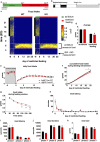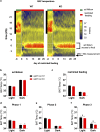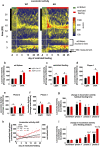Carnitine Acetyltransferase in AgRP Neurons Is Required for the Homeostatic Adaptation to Restricted Feeding in Male Mice
- PMID: 29697769
- PMCID: PMC6692886
- DOI: 10.1210/en.2018-00131
Carnitine Acetyltransferase in AgRP Neurons Is Required for the Homeostatic Adaptation to Restricted Feeding in Male Mice
Abstract
Behavioral adaptation to periods of varying food availability is crucial for survival, and agouti-related protein (AgRP) neurons have been associated with entrainment to temporal restricted feeding. We have shown that carnitine acetyltransferase (Crat) in AgRP neurons enables metabolic flexibility and appropriate nutrient partitioning. In this study, by restricting food availability to 3 h/d during the light phase, we examined whether Crat is a component of a food-entrainable oscillator (FEO) that helps link behavior to food availability. AgRP Crat knockout (KO) mice consumed less food and regained less body weight but maintained blood glucose levels during the 25-day restricted feeding protocol. Importantly, we observed no difference in meal latency, food anticipatory activity (FAA), or brown adipose tissue temperature during the first 13 days of restricted feeding. However, as the restricted feeding paradigm progressed, we noticed an increased FAA in AgRP Crat KO mice. The delayed increase in FAA, which developed during the last 12 days of restricted feeding, corresponded with elevated plasma levels of corticosterone and nonesterified fatty acids, indicating it resulted from greater energy debt incurred by KO mice over the course of the experiment. These experiments highlight the importance of Crat in AgRP neurons in regulating feeding behavior and body weight gain during restricted feeding but not in synchronizing behavior to food availability. Thus, Crat within AgRP neurons forms a component of the homeostatic response to restricted feeding but is not likely to be a molecular component of FEO.
Figures




Similar articles
-
Ghrelin receptor in agouti-related peptide neurones regulates metabolic adaptation to calorie restriction.J Neuroendocrinol. 2019 Jul;31(7):e12763. doi: 10.1111/jne.12763. Epub 2019 Jul 9. J Neuroendocrinol. 2019. PMID: 31251830 Free PMC article.
-
AgRP Neurons Require Carnitine Acetyltransferase to Regulate Metabolic Flexibility and Peripheral Nutrient Partitioning.Cell Rep. 2018 Feb 13;22(7):1745-1759. doi: 10.1016/j.celrep.2018.01.067. Cell Rep. 2018. PMID: 29444428
-
Carnitine acetyltransferase (Crat) in hunger-sensing AgRP neurons permits adaptation to calorie restriction.FASEB J. 2018 Jun 22;32(12):fj201800634R. doi: 10.1096/fj.201800634R. Online ahead of print. FASEB J. 2018. PMID: 29932868 Free PMC article.
-
The Mysterious Food-Entrainable Oscillator: Insights from Mutant and Engineered Mouse Models.J Biol Rhythms. 2018 Oct;33(5):458-474. doi: 10.1177/0748730418789043. Epub 2018 Jul 23. J Biol Rhythms. 2018. PMID: 30033846 Free PMC article. Review.
-
Central orchestration of peripheral nutrient partitioning and substrate utilization: implications for the metabolic syndrome.Diabetes Metab. 2014 Jun;40(3):191-7. doi: 10.1016/j.diabet.2013.11.002. Epub 2013 Dec 11. Diabetes Metab. 2014. PMID: 24332017 Review.
Cited by
-
Ghrelin receptor in agouti-related peptide neurones regulates metabolic adaptation to calorie restriction.J Neuroendocrinol. 2019 Jul;31(7):e12763. doi: 10.1111/jne.12763. Epub 2019 Jul 9. J Neuroendocrinol. 2019. PMID: 31251830 Free PMC article.
-
Metabolic sensing in AgRP neurons integrates homeostatic state with dopamine signalling in the striatum.Elife. 2022 Jan 12;11:e72668. doi: 10.7554/eLife.72668. Elife. 2022. PMID: 35018884 Free PMC article.
-
Gut microbiota suppress feeding induced by palatable foods.Curr Biol. 2023 Jan 9;33(1):147-157.e7. doi: 10.1016/j.cub.2022.10.066. Epub 2022 Nov 29. Curr Biol. 2023. PMID: 36450285 Free PMC article.
-
The Ghrelin-AgRP Neuron Nexus in Anorexia Nervosa: Implications for Metabolic and Behavioral Adaptations.Front Nutr. 2020 Jan 9;6:190. doi: 10.3389/fnut.2019.00190. eCollection 2019. Front Nutr. 2020. PMID: 31998738 Free PMC article. Review.
References
-
- Carneiro BT, Araujo JF. The food-entrainable oscillator: a network of interconnected brain structures entrained by humoral signals? Chronobiol Int. 2009;26(7):1273–1289. - PubMed
Publication types
MeSH terms
Substances
Grants and funding
LinkOut - more resources
Full Text Sources
Other Literature Sources
Molecular Biology Databases
Research Materials
Miscellaneous

